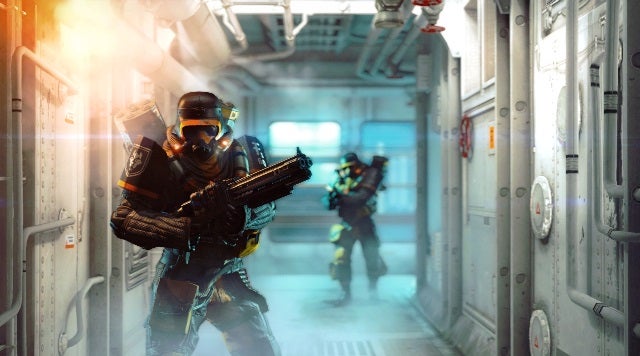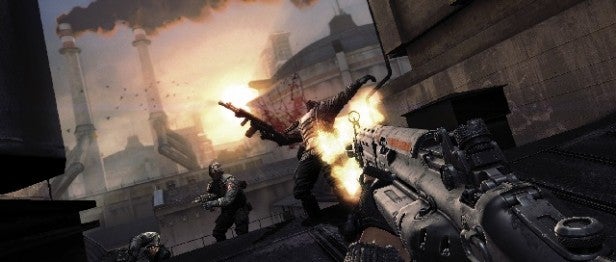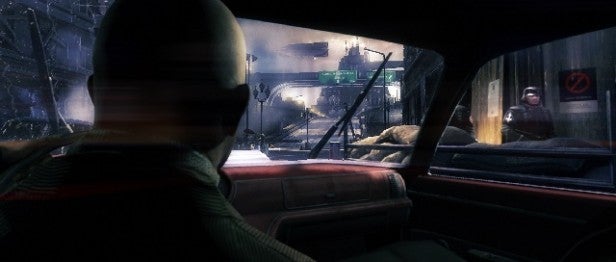Wolfenstein: The New Order Review
Wolfenstein: The New Order
A new Wolfenstein that dares to take the series somewhere different

Verdict
Pros
- Lots of goodies for long-time Wolfenstein fans
- Great alternate history premise
- Interesting blend of old-school and modern FPS mechanics
- Strong graphics and visual design
Cons
- Jarring shifts of tone
- Gameplay inconsistent and sometimes dated
- Dubious enemy AI
Key Specifications
- Review Price: £39.00
Did the world need another Wolfenstein? The last attempt to resurrect the franchise – 2009’s reboot reboot – was pretty forgettable, and even 2001’s Return to Castle Wolfenstein was no more than a solid FPS. Isn’t it time we let the original FPS live on as a vintage classic, rather than a going concern?
Yet there is good reason to get a little excited. While the previous two games were developed by Raven Software, this one’s the debut for MachineGames, a new Swedish developer founded by some of the team from Starbreeze Studios, who you might remember from Chronicles of Riddick: Escape from Butcher Bay and The Darkness.
What’s more, this isn’t just another sequel, remake or re-imagining, but a game that gives Wolfenstein a whole new spin. The usual WWII setting only lasts as long as the prologue, before venturing into a 1960s alternate history where the Nazis, empowered by cutting-edge technology, have won the war.
Out go many of the old Wolfenstein clichés, in come a series of missions that put you in the midst of a desperate resistance, fighting back against a dominant Third Reich whose monstrous ideals have been made flesh.
It’s a good premise, yet there’s more to The New Order than just that. While there’s enough lip service paid to make it a direct sequel to the 2009 reboot, MachineGames has bigger ambitions. There’s been a lot of talk about the team’s love of the original Wolfenstein, but also of the way that the game has been inspired by the work of Quentin Tarantino, and you can see both elements at play in the finished game.

If, like some of us, you’ve played every Wolfenstein since the 1992 original, then The New Order will do more than just make you feel really old; you’ll spot the way old tropes like eating dog food and roast dinners for health, or searching areas for hidden doors have made it into the latest game. You won’t have to look far to find references to the original, or see ways in which old enemies or weapons have been retooled for a modern game.
Meanwhile, The New Order tries to do what Tarantino did with Inglourious Basterds and Django; grab hold of a dying genre or a half-forgotten cult classic, and take it somewhere strange and unexpected.
On one level it’s a classic, old-school FPS with a ridiculous hero, some very big guns and an awful lot of Nazis in need of killing, yet all the time you can see MachineGames trying to push Wolfenstein into areas where it hasn’t gone before – to humanise the characters, give you moments of suspense or terror, and even confront some of the worst horrors of the Nazi regime.

As with the Tarantino movies, not all of it works. The shifts of tone from crowd-pleasing violence to outrage at Nazi violence are jarring, the brutal torture scenes are hard going, and it’s all too much weight to place on the shoulders of B.J. Blazkowicz; a character whose emotional range has previously run all the way from Angry to Badass. Yet there is something a bit more sophisticated going on here, and a handful of scenes are genuinely effective.
Strong visuals also help. It might have been built for the last-gen consoles, but iD’s Tech5 is still no slouch on PC or the next-gen platforms, and The New Order runs smoothly at a crisp 1080p on PS4.
At first, it looks a little like a PS3 game given a resolution boost for the new console, but the longer the game runs, the more impressive its lighting, its characters and its ultra-detailed textures become, particularly given the size and scope of the some of the levels. The sci-fi Nazi uniforms are brilliantly realised, and the Nazi-fied visions of London or Berlin creepily atmospheric.

Unfortunately, if there’s one thing that holds The New Order back, it’s the gameplay. As appealing as the sound of a proper old-school FPS might be, the reality isn’t quite so simple or so great.
On the one hand, the number of enemies and the dumbed down AI give it something of the old-school Wolfenstein feel. Your Nazi foes know enough to run around a bit and loiter behind cover, and there are enough of them to make for some pretty intense firefights. Yet they rarely do anything to surprise you, and weight of numbers and huge armoured robots soon become the game’s prime strategy for maintaining a challenge.
Oddly enough, this discourages you from all-out attack, and so you start employing stealth instead. This isn’t necessarily a problem. The game supports different approaches through a system of perks, where you’re rewarded for say, dual-wielding weapons or regular sneak attacks with bonuses that make these strategies more effective.
Taking out commanders becomes a good strategy, as this puts a stop to the flow of reinforcements. However, the more we found assault tactics ineffective, the more we kept on coming back to sneaking around or headshot strategies. These then became more effective, which is fine but makes the game feel less like Wolfenstein. MachineGames also seems to have inherited Starbreeze’s obsession with crawlspaces and sudden knife attacks, which can get wearing.

At times The New Order can also feel dated – even a trudge. We like hub areas and chances to get to know the secondary characters better, but do we have to have them filled with fetch quests? Or sewer sections that feel like they’re there to pad out an already pretty sizeable game? A lot of the big action sequences could have come from any mid-noughties FPS, and some of the set-pieces feel like off-cuts from Call of Duty: Black Ops or Modern Warfare.
Why so many pseudo-boss battles against heavily-armed robot enemies, particularly if you’re going to make them so predictable? Some of these fights are closer to tests of ammo-discovery and conservation than trials of skill or courage. As much as we like to see some old things return, like health packs, armour and crazed Nazi scientists, other things like dubious checkpoints and the old ‘locked door suddenly opens releasing squad of Nazis’ trick prove that being a throwback isn’t always a good thing.

There are also places where the action could be more polished. You have a great selection of weapons, with two always to hand and the rest accessible through a weapon wheel. However, using the quick-swap button doesn’t help when both are out of ammo, and using the wheel in the heat of battle is suicidal. Ditto trying to unmount or re-mount and replenish turret-based guns.
You can pick off Nazis one-by-one with stealth tactics, but you can forget trying to move them so they don’t alert their comrades, and in certain situations you’ll find your Fuhrer-loving foes collapsing through the scenery after their demise. These aren’t huge issues, but they leave the game feeling slightly sloppy.
This stuff is dispiriting, yet there’s still a lot here to love. When you’re knee-deep in Nazi corpses in the middle of a Nazi space exploration exhibition, pumping shotgun rounds into squads of guards during a prison breakout, or taking vengeance on sadistic Nazi officials in a labour camp, The New Order’s weird mix of straight-up action, grindhouse attitude and sci-fi Nazi nonsense slots into place. When that happens, the return of Wolfenstein suddenly becomes a great idea.
There’s no multiplayer mode, but MachineGames has worked hard to ensure you get your money’s worth from the single-player game. Chapters are many and quite meaty, while collectibles, the perk system and a range of unlockable game modes boost the replay value. In fact, the storyline encourages you to play through twice, with an early choice that results in a slightly different skillset for each run.
Verdict
We love the latest Wolfenstein for the respect it pays to iD’s original, and for the ways it tries to take the series somewhere new. We’re not so keen on some elements of the gameplay, and it must be said that not all its loftier ambitions quite pan out. What we’re left with is a solid FPS that’s always interesting – and one with an identity all its own – even if it can’t make it up there with the best-in-class.
Read more: The Division rumours

